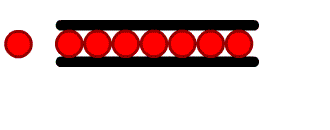Electricity itself travels through wires at the speed of light x velocity factor. So a cheap piece of RG-58 coax cable with a 75% velocity factor can transmit radio waves at 75% of the speed of light.
The confusion comes in because we don't use just DC current to transmit information, but rather an alternating current or an alternating current impressed on a DC voltage (modulation) to do this. Each transmission medium used has a maximum frequency at which it will operate. Telegraph using switched DC 5-50wpm (a wire suspended on poles with an earth return), A standard POTS line may pass 4kHz (rural parallel 2 pair cable with shield), a DSL line close to the DSLAM might pass 2MHz (twisted pair from DSLAM to house), a CAT5 Ethernet twisted pair cable 100MHz and so on. Typically, the higher the frequency that the transmission medium can support, the higher the datarate that can be passed through it.
The electricity passes through the cable at the same speed, but the increasingly higher switching rate carries more and more information.
On top of this concept of using electricity to transmit information is the type of modulation used.
Close in, simple square wave serial may work just fine. It comes in many flavors. TTL uses a 0-5 volt shift, RS-232 uses a voltage swing between positive and negative 3-15 Volts. etc. etc.
For POTS phone lines, transmitting a square wave would not work, the characteristics of the line turn it into a sine wave, so various modulation schemes are used like amplitude shift, frequency shift, phase shift or a combination of these used in QAM which can be used to increase the datarate from 150bps to 56kbps.
DSL operates at a much higher frequency than POTS and using a modulation technique called Discrete Multi-tone, operates over multiple carrier frequencies (think radio AM band and receiving all the stations at once, each one carrying a data signal and combining them at the other end) using phase and amplitude shift modulation, reaching a datarate of 1-7Mbps.
This covers local loop, when we get into the internet backbone we start using stuff like Digital Signal (DS) and Optical Carrier (OC) media to move the traffic using PCM (Pulse Code Modulation) techniques over multiple channels. These are the true digital part of the network. Once again the traffic moves at near light speed, but the datarate is dependent on the frequency and modulation technique being used.
Addendum: Electrons move from one atom to another a minute distance. The current flow we perceive as electricity is a near instantaneous cascade of electrons moving from one atom to another over the length of a conductor.

1
This is by no means an answer, and I am not a physics professor, but there is an interesting discussion on the speeds of electricity here that may be useful to you. And as a note of interest, check into some "powerline" ethernet adapters - they allow you to share gigabit ethernet across the power grid in your home/office etc, at full gigabit speeds. I can't think of a good way to compare the speeds of the two, but maybe there is someone here who can explain the concepts involved.
– Josh – 2012-02-19T16:06:53.320I have that concept, but the problem i can't imagine is: When you transmit data, don't you want to transmit specific 1's and 0's? or this is even more low-level than that? Cause if no, then how can you specify what you are transmitting? – Delison – 2012-02-19T17:14:34.500
5
Electrons drift through wires very slowly, but the signal (or energy) will propagate close to the speed of light.
– sblair – 2012-02-19T18:36:49.2835@Delison - there is no such thing as transmitting 1s and 0s; those are a matter of interpreting something that is transmitted. If you vary the current on a wire, and we've agreed ahead of time that anything over X volts will be considered a 1 and anything under Y volts a 0, it's our mutual standard of interpretation (aka "protocol") for an analog, real-world thing which creates binary information. We could just as well throw sticks over a wall and measure them; anything longer than 10cm would be a 1; smaller would be a 0. Binary data is interpreted, not sent or stored. – Nathan Long – 2012-02-19T20:57:39.097
See also: http://programmers.stackexchange.com/a/132705/7217
– Nathan Long – 2012-02-19T20:59:17.707@NathanLong +1 for the distinction between the data and the transmission standard. As an instance, Morse code isn't on/off digital but a differentiation between on and on x 3 with groupings of the same separated by longer off giving the symbol transmitted. We can use amplitude, frequency, phase, pulse width, etc. as the basis of the modulation and with really accurate clocks on both ends even time division multiplex for transmitting multiple data channels. It's the standard set in place that determines if anything intelligible comes out. – Fiasco Labs – 2012-02-19T21:28:44.030
-1 "electricity is very slow" any references? – Kris – 2012-02-20T07:43:45.903
@NathanLong exactly, and it's not even a matter of the voltage being above or below a certain voltage all the time either. For wireless or PLC there is a carrier wave and the voltages must be relative to that.
– Codebling – 2012-05-29T17:54:49.580